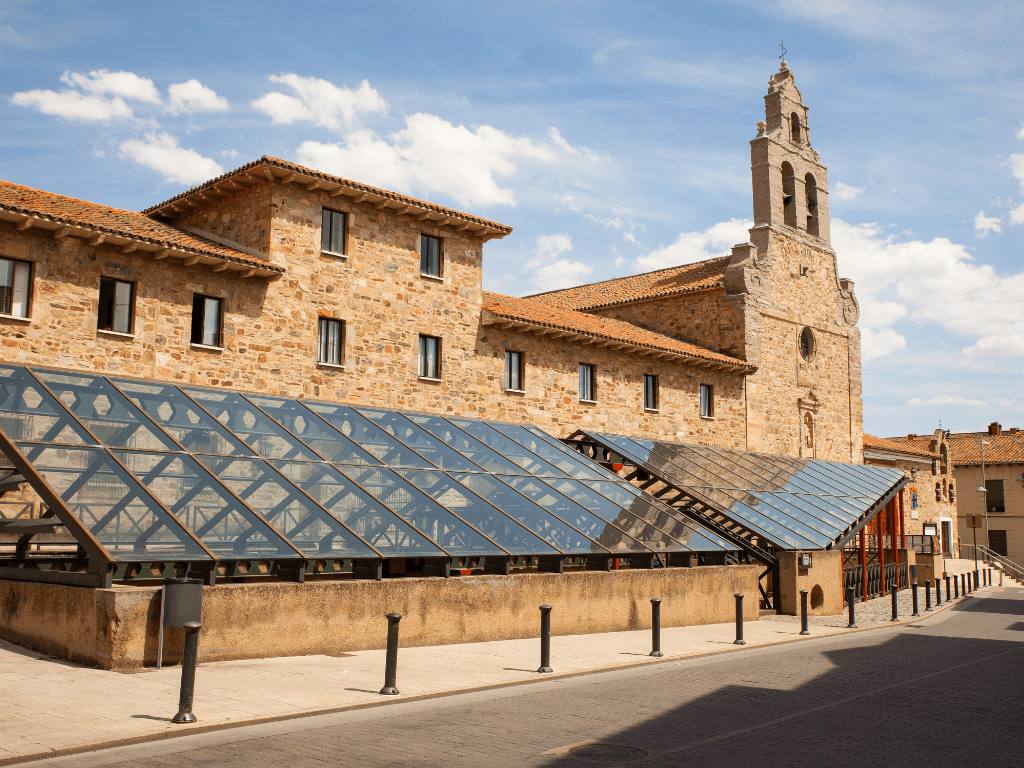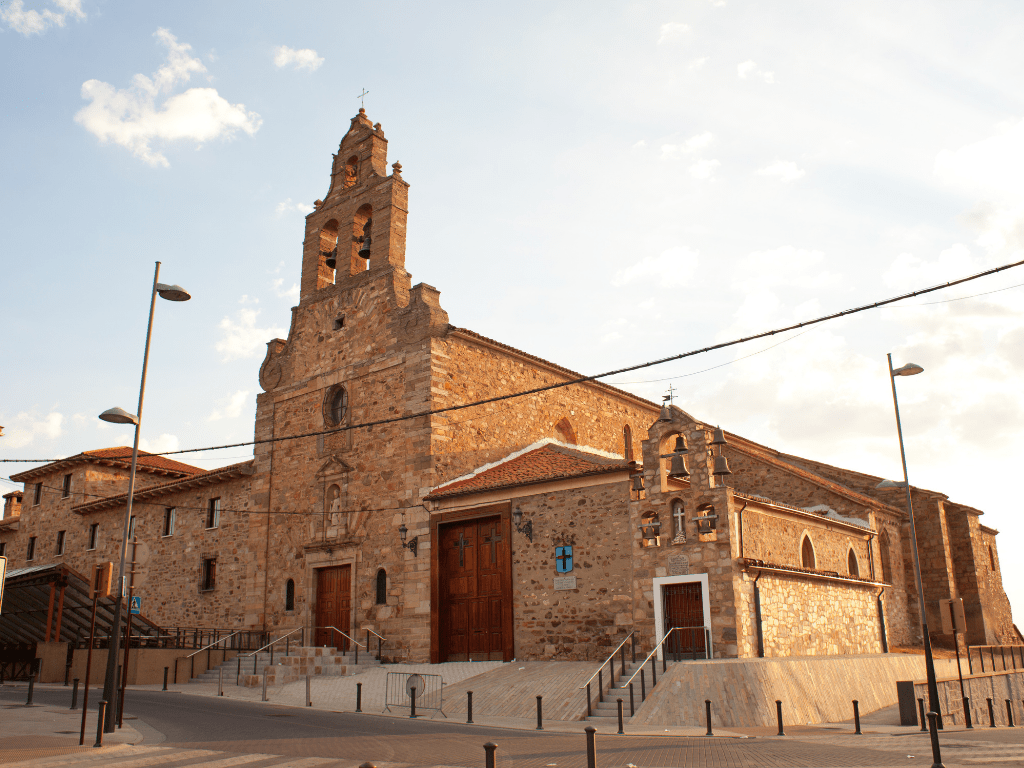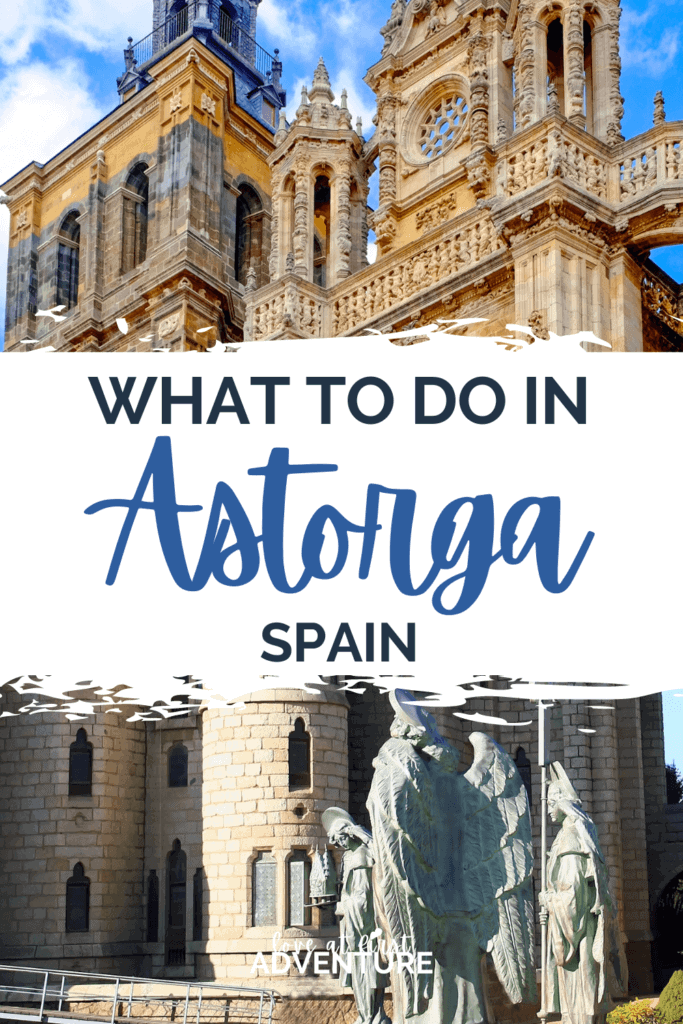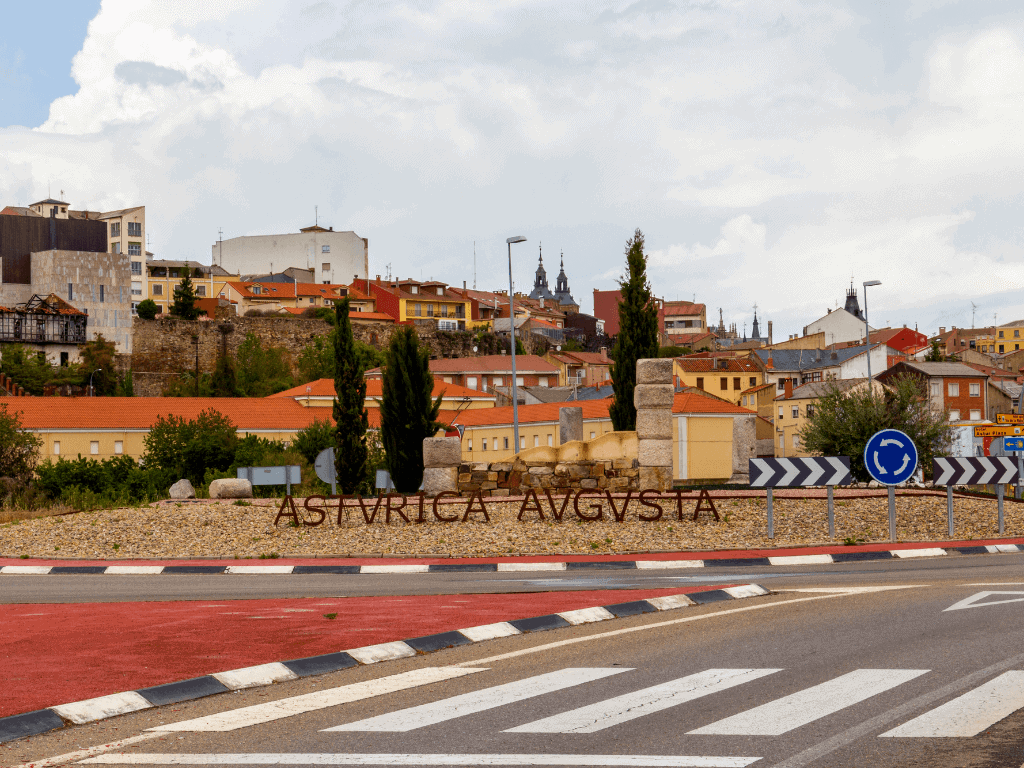10 Terrific Things to Do & See in Astorga, Spain
Disclaimer: Links on this page may be affiliate links. If you make a purchase after clicking a link, I may receive a small compensation to help power my site.
Astorga, Spain is a magical town located 200 miles northwest of Madrid in the Castile and Leon region. A premier destination along the Camino de Santiago pilgrimage, this unassuming town is sure to surprise pilgrims and travelers alike. Stroll through the main thruway, and you’ll quickly find its connections to Rome and the ancient pilgrim route as well as delicious regional treats.
In this article, we’ll review 10 amazing sights and must-do activities in Astorga, Spain.
A Brief History of Astorga
Nestled along the Tuero river, Astorga is a quiet city upon first glance. However, it has seen a lot in its 2000 years of existence. Officially founded by Rome and later destroyed by Napoleanic wars, it stands today rich in history and architecture. In Roman times, Astorga was established as a communications hub during the gold trade. It still contains many archaeological remains, some buried and others unearthed for all to see.
During the Middle Ages, Astorga became prominent due to the passage of pilgrims along the Camino de Santiago. Two of its routes, the Camino Frances and the Vía de la Plata, cross through Astorga. A pilgrims hospital was built near the convent of San Francisco (#10 on this list) and provided assistance to weary and/or injured pilgrims. The existence of the hospital is documented in the 15th and 16th centuries, at the least.
Today, Astorga is the head of one of the most extensive and oldest dioceses of Spain. It’s also rich in customs and architecture of the Margatería, a small ethnic and cultural community.
10 Things to Do in Astorga, Spain
To help you make the most of your time in Astorga, here are some amazing things to do and see.
1. Astorga Cathedral

The impressive Astorga Cathedral or the La Catedral de Santa Maria de Astorga stands tall and beautiful near the old city center. Spend some time marvelling outside at the intricate Baroque facade. It shines golden yellow or orange depending on the sunlight while the back part remains grey.
The entrance to the cathedral is through the gift shop to the left of the main church gate. Here, you can pick up an audio guide (English available) that comes with the small entry fee. Examine the numerous religious artifacts on display in the diocesean museum before reaching the interior sanctuary. Built between the 15th and 18th centuries, the interior features Gothic, Neo-Classicist, and Renaissance style architecture.
2. Gaudí Palace

The proud icon of Astorga is the Palacio de Gaudí. Located right next to the Cathedral and looming above the old city walls, it resembles a fairy tale castle of sorts. But, its neo-Gothic facade isn’t just a sight to behold from the front. Hence, take a walk around the grounds and into the park behind to get a good look from all angles.
Although known widely today for his masterpieces in Barcelona, Catalan Antoni Gaudí designed this palace for the Episcopal bishop in the late 1800’s. It is Gaudí’s last completed work/ Moreover, it’s one of his only three works outside Catalonia! The palace alone is worth a stop in Astorga.
A visit inside the museum is a must for fans of Gaudí, new and old. Enjoy not only the unique architecture, but also the intricately placed stained glass windows and ceramic tiles. Additionally, the palace houses the Museum of the Caminos (Museo de los Caminos, established in 1963) with information and historical relics from the pilgrimage to Santiago. An audio guide is available.
3. Spa Hotels

A relatively small city, Astorga is a great place to rest along the Camino or on a road trip. It boasts multiple spa hotels. Fairly priced, they offer various pools, saunas, waterfalls, Turkish baths, and more. Massage services are also available.
If you do not wish to stay at the hotel, you may still purchase an entrance pass. A pass at PortBlue costs 18/19€ and Hotel SPA Via de la Plata costs 12€ on Sundays for a 1.5 hr spa pass.
4. Chocolate Museum
Well known in Spain for its sweets, Astorga has a chocolate museum dedicated to Astorga’s booming chocolate industry of the 18th and 19th centuries. While the small museum alone isn’t a reason to visit the city, it’s worth a quick visit to understand how chocolate came to be a part of Astorga’s history.
Even though non-Spanish speakers won’t understand the written displays, the many artefacts and the taste test at the end are nevertheless enjoyable. There’s a gift shop where you can purchase Astorga chocolate, but feel free to pick it up at any shop in town.
Recently, Astorga’s chocolate legacy continued as it won Ferrero Rocher’s 2020 contest. The chocolate giant lit up the plaza and surrounding streets in a spectacular and joyful winter display.
5. Roman Museum

Like much of the world at the time, Astorga too was under Roman control. Quite interestingly, the Roman museum (La Ergástula) is built over some of the partially excavated ruins. It contains a small but exquisite collection of historical documents, ruins, and artefacts. Outside the museum, there are various Roman ruins throughout the town such as the roman baths.
A guided tour (in Spanish) is available, but fills quickly, so book in advance. If the tour is full, you don’t speak Spanish, or you just don’t like tours, you can still walk around to see the villa, the Forum, the sewers, and baths, located outdoors.
6. Ancient City Walls

The old city is partly enclosed by ancient city walls. Said to have been built in Roman times and renovated in the Middle Ages, they are nothing short of impressive. To get a good look at the walls, head down the stairs behind Gaudi’s Palace.
Take a short walk in the calm and manicured Parque del Melgar along the wall, which clearly separates old city construction from new. As you are admiring the walls, the entire Episcopal palace is easily seen, making this a great spot for a rest, reflection, and some panoramic photos.
Free parking is also located at the southeast entrance to the park.
7. Plaza Mayor de Astorga

The Plaza Mayor de Astorga comes alive in the evenings with pilgrims and locals alike. Enjoy a taste of the local stew called cocido maragato at one of the nearby restaurants before people watching in the Plaza. Undoubtedly, you will be mesmerized by the juxtaposition of elderly Spaniards strolling in their Sunday best, children playing soccer at all hours of the night, and pilgrims resting after a long day on the Camino.
At the far end of the plaza, you’ll find Astorga’s City Hall, the Ayuntamiento de Astorga. The 17th century building is Baroque in style and every bit as impressive as the cathedral down the street. Be sure to catch the show as two maragato figures strike its bell tower every hour.
8. Casa del Sacristán

The Casa del Sacristán is a 17th century house located just outside the Cathedral. In fact, it’s the oldest civil building in Astorga. Belonging to the church, the sacristy retains the characteristics of the Gold Era. With the church in plain view, it seems like a watchtower of sorts. Oddly, this characterization is fitting as the dignity here once guarded sacred objects like vessels, vestments, and books.
Currently, the house is a peculiar optical museum. On a 20-minute tour through the home, delight yourself as you try to figure out the many illusions in store. The tour costs 5€.
9. Astorga’s Pastries

In addition to Astorga chocolate, don’t leave town until you test some of Astorga’s traditional pastries! Mantecadas and hojaldres are two tasty treats.
Although mantecadas can be found in other regions of Spain, these spongy pastries traditionally hail from Astorga. Similar to a muffin, they are baked in paper. However, the buttery mantecadas are usually baked onto a square paper, which leaves cross-shaped crumbs behind when opened! Hojaldres are puff pastries with honey which are also now commercially available in the country.
Stop at any bakery, grocery, or ask if these are served at the café where you’re eating to enjoy one!
10. Iglesia de San Francisco

Juxtaposed against the Roman museum, you’ll find a lovely church with two flat steeples. The Iglesia de San Francisco (St. Francis’s church in English) is rumored to have been established by St. Francis himself. Since 1883, it’s been linked to the oldest brotherhood, the Santa Cruz or True Cross. Today, the Catholic confraternity continues to seek to preserve its history and religious traditions.
The small hall next door is the first religious space that pilgrims encounter on their way to Santiago and deserves a moment of pause. Two prominent, flat bell towers make up the front facade.
Across from the church, the old convent is now used as the municipal pilgrim’s hostel, the Albergue de peregrinos Siervas de María. You may also attend the nightly pilgrim’s mass in the chapel and enjoy a moment of peace in the adjoining garden.
How to Get to Astorga, Spain

Astorga is easily accessible by train and bus from various nearby towns. Depending on where you are coming from or the time of day, you may opt to take a combination of train and bus.
Check out these good options to get to Astorga, Spain:
By foot
Astorga is a stop on the Camino Frances and the Vía de la Plata pilgrimages to Sanitago. Pilgrims walking one of these two routes can expect to visit Astorga after arriving in the Castile and Leon region. Astorga is also a popular starting point for the Camino (see our 14 day itinerary – link coming soon).
By train
The Astorga train station is located just at its outskirts. From there, the walk to the old town is about just 15 minutes through residential streets. Since Leon is the capital of the region, many trains from other cities go to Leon. From Leon, you can then transfer to Astorga via train (4x day) or bus (3x day). In Leon, the bus station is located within walking distance of the Leon train station should you need to transfer.
Here are a few of the major train routes:
From Bilbao: 5.5-6 hrs, $40
From Leon: 30-45 minutes, $7
From Madrid-Chamartin: 3-5 hrs, $50-$80
From Santiago: 4 hrs, $30-$40
From Porto, Portugal: 27 hrs overnight, $46-$50
By Bus
It’s often cheaper to take the bus. Additionally, there are typically more buses running each day than there are trains.
Here are the routes in which the ALSA bus line is cheaper and/or faster than the train as well as routes from some nearby cities:
From Leon: 45-50 min, $5-$6
From Oviedo: 2 hrs, $17
From Valladolid: 2.5-4.5 hrs, $19-$22
From Salamanca: 1-2.75 hrs $10-$21
From Santiago: 4.5-7 hrs, $31-$42
From Lugo: 2.25-3 hrs, $17-$20
From Madrid: 3.5 hrs, $33
Check current train and bus schedules and prices.
By Car
Astorga is a great place to visit on a road trip for the day. Located 40 minutes east of Leon, it can be accessed on the AP-71 and A-6 highways. Upon arrival in Astorga, visitors can ditch the car for the day. (There is free parking at most hotels and near Melgar Park). All the sights are within walking distance, and much of the area is pedestrianized.
Places to Stay in Astorga
Astorga has few unique, clean, and affordable options, making it a great stop for the night. You can get hostel accommodations or opt for an evening at a spa hotel. Listed below are a few of our top picks.
Pilgrim Accommodation
There are several pilgrim hostels in Astorga. We recommend one of these two.
The Municipal Albergue
The municipal albergue in Astorga is a large, clean facility with plenty of beds, kitchen space, and areas for socializing overlooking the nearby rooftops. It is located just steps away from the Roman museum. It is first come, first serve and costs 5€.
Albergue Só Por Hoje
The darling Albergue Só Por Hoje is a dream come true with only single beds – no bunks! Particia welcomes guests to this comfortable and inviting hostel just a few blocks from the Plaza Mayor. The amenities are basic, but it has everything that you need like your own nightlight, towels, and sheets. (Beds start at $30, breakfast included.)
Check current prices, and read reviews on Booking.com.
Mid-range: Hotel Astur Plaza
Located on the main square, this 3* hotel features a nice restaurant serving traditional fare and a lounge area with a glass roof. Although we don’t usually recommend staying on the plaza, this hotel is an exception as it’s quiet in comparison to many of the other plazas we’ve encountered in Spain. It’s right in the middle of all the touristic spots, and the friendly concierge will point you to the nearby landmarks and spa hotels. There is also a free parking garage on the premises and a breakfast option. (Rooms start around $70.)
Check current prices, and read reviews on Booking.com.
SPA Hotels: Hotel SPA Vía de la Plata
If you’re looking for a relaxing evening, this hotel’s the place. Hotel SPA Vía de la Plata is located just 350 feet from the plaza. Elegantly decorated, the hotel’s spa includes a thermal pool with hot tub, loungers, Finnish and Turkish saunas, and a UVA cabin. Access to the spa and treatments and massages are also available for an extra charge. (Single rooms start at $82.)
Check current prices, and read reviews on Booking.com.
Booking Resources
Check out our recommended booking tools for visiting Spain. You can even Bookmark this page so that you can refer back to it when ready to book.
Flights:
- Google Flights – To get an idea of flight prices and routes, browse Google Flights by using the exploration map.
- Momondo – Best search engine (powered by Booking.com)
Accommodations:
- Booking.com – Access a clear, easy hotel booking process and ability to see itinerary on the APP.
- Hostelworld – the leading provider of online hostel reservations to budget, independent, and youth travelers
- Airbnb – Rent an entire apartment during a rest day in one of the larger cities (Use my link to get $65 off your first stay
Transportation:
- Begin planning your in-country travel with Rome 2 Rio, a website offering multiple routes including air, train, bus, or car.
- For train and bus travel, consult Rail Europe and Trainline (our preference). You can also purchase Spanish train tickets directly from Renfe and bus tickets from ALSA or Flixbus.
- Bla Bla Car – Ridesharing APP
- Rental Car
Travel Insurance:
- World Nomads – Unfortunately, injuries & mishaps happen! Don’t forget to protect yourself and your trip by purchasing travel insurance (under 70).
- InsureMyTrip – If you’re over 70, check here for the best plans.
Check out our resources page for more booking tools we use to plan our trips!
Ready to visit?
There you have it, friends! Lucky for us, Astorga has retained its historical charm after many years in existence. Although it’s closely tied to the Camino, any traveler would enjoy a day ot two in the town.
People that visit Astorga fall in love with the magical palace, ancient city walls, and other historical buildings juxtaposed against modern day apartment buildings. Our advice in regards to falling in love with Astorga? Just embrace the experience, and find ways to interact with locals and the many pilgrims passing through each day.
Heading to Astorga? You may also like
Planning to visit Astorga, Spain on the Way of St. James? Check out some of our top articles:
Pin it!



Its indeed amazing how these points of interest in Spain have such rustic, and yet refined architecture as well. Certainly, I would love to visit here one day =)
I hope you do. Spain is full of surprises!